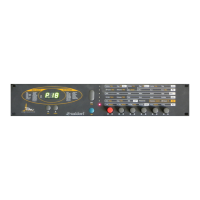54
User’s Manual Pulse • PulsePlus
13. Tips and Tricks
Here are a few tips that will help you make the most of your Pulse.
• The lower the input signal, the greater the effect the filter has on the overall sound.
If you want a heavily filtered sound, set the oscillators' volume parameters to low
values in the mixer. On the other hand, high oscillator levels produce purer sounds.
• If you want a more aggressive sound, simply turn up the oscillator volume levels so
that they are just below the saturation point. The mixer's output signal will crosstalk
with the filter frequency and produce a rougher sound.
• You can achieve typical analog synthesizer distortion by overloading the connected
mixing console's input. You can also experiment by patching effects processors
between the Pulse and your mixer.
• Try using an LFO to modulate the panorama position. This produces interesting
stereo effects, especially at high LFO frequencies.
• The Pulse's output signal is not interrupted when you change programs. Try
exploiting this feature by using MIDI program change messages to line up a series
of different sounds.
• Change the relative pitches of the oscillators at musical intervals. Thirds (mediant),
fifths (dominant) and sevenths (subtonic) are suitable for this application.
• Self-oscillation of the filter at high resonance values produces sounds that are great
for soloing.
• Modulate the oscillator's pitch drastically so that the upper frequency threshold is
exceeded. This will produce interesting results.
• Program a pitch modulation in musical intervals. The section entitled "Modulations"
contains an assignment table listing the Mod Amount parameters and the
corresponding semitone intervals. For example, you can modulate from a major
chord to a minor chord via the mod wheel.
• Assign a Keytrack modulation to the LFO speed. It should modulate the LFO in
proportion to the incoming note. You can thus achieve even frequency fluctuations
over a wide range of your keyboard.
• Modulate the pitch of an oscillator via Keytrack. Set the modulation "Amount" so
that this value is numerically equal to the "Tune" value of the oscillator, but make
one value positive and the other negative. This generates frequency fluctuations that
oscillate at the same speed throughout the range of the keyboard. Experiment with
different Amount values by alternating low and high notes.

